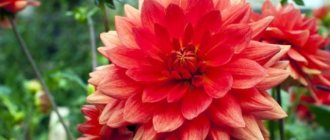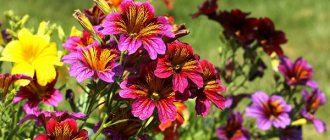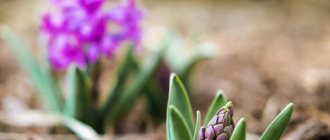Calendula is also called marigold. This herbaceous plant belongs to the Asteraceae family. In nature, marigolds can be found in Western Asia, the Mediterranean, and also in Western Europe. The name of this flower comes from the Latin word calendae, which means “first day of the month.” This genus includes about 20 plant species, among which there are both annuals and perennials. There are types (for example, medicinal marigolds) that are not only very beautiful, but also have healing properties. These properties were first mentioned by Dioscorides, who lived in the 1st century AD. e. and was an ancient Greek physician and philosopher. Marigolds were also used to create healing remedies by Galen, Avicenna, Amirdovlat Amasiatsi and the famous herbalist Nicholas Culpeper. Once upon a time, marigolds were used as a vegetable plant, so they were used to make wine, pudding, fillings for dumplings, and they were also put in oatmeal and soups. This plant was called the poor man's spice. The fact is that overseas spices were very expensive, and calendula could be an excellent replacement for saffron. It made dishes more tart and gave them an orange-yellow tint. This plant has gained immense popularity in European countries. Shakespeare himself mentioned such a plant in his work, while Queen Margarita of Valois (Queen Margot) of Navarre preferred marigolds to all other garden flowers.
Features of calendula
Such a herbaceous plant has pubescence, which is a glandular fluff. The flowers can be yellow or orange. They are multi-flowered apical baskets, which include sterile tubular inner florets (often darker in color) and outer pistillate fertile pseudolingulate florets. Simple alternate oval leaf blades can be elongated or lanceolate. The fruits are achenes, which can be curved or ring-shaped, and they are placed in 2 or 3 rows. Flowering begins in June and ends in November. A lot of seeds are produced, and they remain viable for 5 years. Marigolds have been cultivated as decorative flowers since the 16th century.
Calendula. Planting and care.
Medicinal and beneficial properties of calendula
All the healing qualities and beneficial properties of marigolds are well known, therefore plant raw materials are actively used in therapeutic and preventive measures for many diseases. The composition of the plant is enriched with:
- carotenoids;
- coloring pigments, including beta-carotene;
- sterols;
- alcohols;
- triterpenoids;
- oleanoic acid glycosides;
- flavonoids;
- essential oils;
- coumarins;
- K and Ca;
- Mg;
- Ferrum;
- Zn;
- Cu;
- Mo;
- F;
- Se.
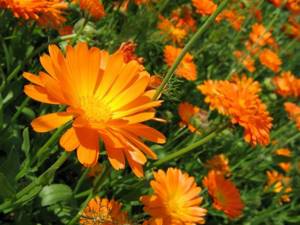
Plant raw materials are used for self-production of decoctions, infusions and tinctures with alcohol . Traditional recipes are used to treat purulent wounds and cuts, burn surfaces, ulcers and fistulas. The common calendula flower, together with chamomile, is widely used to prepare products with a bactericidal effect, so such medicinal preparations are used for sore throat, diseases of the upper respiratory tract, and the oral cavity.
The extract effectively treats hypertension and heart disease, helps fight gastritis, gastric and duodenal ulcers, and gallbladder pathology. Doctors recommend taking medicines based on marigolds to treat gynecological diseases in women, including polyps and fibroids.
Growing calendula from seeds
Sowing in open ground

If you want to spend less effort, you should sow the seeds in open soil in April or October. In spring, you should start sowing after the soil dries out and warms up after the massive melting of the snow cover. To check the readiness of the soil for sowing this plant, you need to collect a handful of soil in the garden and squeeze it in your fist, and then you need to throw it from a hundred centimeter height. If the soil is ready for sowing, the lump should completely crumble. The soil must be prepared for sowing. So, approximately half a month before the planned sowing date, it will need to be dug up, while adding fertilizer. So, per 1 square meter you should take 20 grams of potassium chloride and superphosphate, 3 to 4 kilograms of humus and 30 grams of urea. However, experienced gardeners recommend doing this procedure in the autumn, only in this case nitrogen-containing fertilizer will need to be added to the soil in the spring months. Seeds should be buried 10–20 mm into the soil. In this case, a distance of 25 to 30 centimeters should be maintained between the bushes, the distance between the rows should be from 0.6 to 0.7 m. If such plants are grown as medicinal raw materials, then the distance between the bushes should be from 7 to 10 centimeters, and the row spacing should be from 0.3 to 0.4 meters. If everything is done correctly, the first seedlings will appear within 7 days. 15–20 days after the appearance of the first shoots, the plant will need to be thinned out, and a distance of at least 25–35 centimeters should be maintained between seedlings. Those seedlings that are extra need not be thrown away, but rather replanted. The fact is that calendula tolerates transplants very well. Flowering will begin approximately 2.5 months after sowing.
Sowing seedlings

The seedling method of growing marigolds helps to bring the moment of flowering closer. It is also recommended to grow low-growing varieties using seedlings. Sowing of seeds should be done in the last days of March or the first days of April. You can sow them either in individual cups or in a container, using a flower soil mixture. The seeds should be buried only a couple of centimeters. The crops should be covered with film and placed in a well-lit, warm (18 to 20 degrees) place, protected from direct sunlight.
How to care for seedlings

After the seedlings appear (usually this happens after 6–8 days), the shelter must be removed and the containers must be moved to a place with a lower temperature (from 14 to 15 degrees). Such plants require timely watering and fertilizing once every half month or ten days, using a weak solution of complex mineral fertilizer. When the marigolds have a pair of true leaves, they will need to be planted in individual containers or in a larger container, while maintaining a distance of 5 centimeters between the plants.
Calendula. Seedling.
Planting calendula in open ground

What time to plant
After the plants have 5 or 6 leaves, they should be transplanted into open soil. As a rule, this time falls in the second half of May. But it should be remembered that before planting, the seedlings will need to be hardened off, and this despite the fact that these flowers are quite winter-hardy and tolerate spring frosts well at night. To harden the plants, you need to transfer them every day for a short period of time to a covered terrace or balcony for seven days.
For planting, you need to choose a lighted area, and the soil should be moist, well-drained and saturated with nutrients. Experienced gardeners try to plant such flowers in the inter-rows of other garden and vegetable crops, which is a preventive measure against certain harmful insects (ticks, butterflies and their larvae). However, you cannot plant such a plant next to basil or radishes, as otherwise they will grow very slowly.
How to plant

Seedlings should be planted in open soil using the same scheme as when sowing such a flower in the garden. So, between the bushes you need to maintain a distance of 25 to 30 centimeters, and between the rows you need to leave a distance of 0.6 to 0.7 m. At the same time, for plants grown to create medicinal raw materials, you will need a distance of 7–10 centimeters, while the row spacing should be from 0.3 to 0.4 meters. Plants begin to bloom 40 to 50 days after sowing the seeds.
This plant can reproduce independently by self-sowing.
Caring for calendula in the garden

Caring for your nails is very easy. So, they need to be watered only during periods of prolonged drought; they should also loosen the surface of the area and remove weeds from it. Calendula also requires fertilizing with complex mineral fertilizers once a month. But when growing such a flower, you should remember that after the position of the opened inflorescences becomes horizontal, you should remove from the bush all those flowers that are already open, this will allow the plant to bloom even longer and more luxuriantly. As a result of this, a lot of buds will appear, and the calendula will bloom for a long time. But at the same time, fully opened inflorescences must be picked off regularly. If you do not do this, the plants will bloom in the last days of July.
How to propagate
This plant is propagated exclusively by seeds.
Pests and diseases

It happens that these flowers become infected with powdery mildew or black spot. If brown or black spots appear on the leaf blades, this means that it is infected with black spot. In case of infection with powdery mildew, a whitish coating appears on the shoots, leaf blades and flowers, which becomes brown over time, the infected parts stop growing and change their color to black. The infected plant becomes less frost-resistant. You can get rid of such diseases by treating infected bushes with fungicidal agents (Topaz, Topsin, Skor or Fundazol). Preventive measures:
- thin out plantings in a timely manner;
- remove weeds in a timely manner;
- feed flowers correctly, especially paying attention to nitrogen-containing fertilizers;
- remove plant residues from the site;
- carry out deep digging of the site in the autumn;
- remember the rules of crop rotation;
- identify diseased bushes in a timely manner and remove them from the site.
Only aphids can settle on this flower, while other pests avoid it. This plant has one peculiarity - it is able to attract all the aphids present in the garden, which greatly facilitates the fight against such a pest. To destroy it, you should use such means as: Karbafos, Fufanon, Actellik, Antitlin, Akarin or Biotlin.
Contraindications
In this section we will talk about calendula - indications and contraindications for the use of plant-based medicines.
Indications:
- colds, ARVI, flu;
- gastritis, stomach and intestinal ulcers;
- intestinal disorders;
- diseases of the biliary tract and liver;
- heart diseases that occur with rhythm disturbances;
- hypertension;
- proctitis and hemorrhoids;
- headache;
- bleeding gums and other dental diseases;
- dermatological diseases;
- wounds and burns;
- cystitis;
- inflammatory gynecological diseases;
- painful menstruation.
Contraindications:
- individual intolerance;
- low blood pressure;
- heart failure;
- pregnancy and breastfeeding;
- simultaneous use of anticoagulants;
- simultaneous use of sedatives;
- simultaneous use of antidepressants.
Before using calendula-based medicines, be sure to consult with your doctor.
After flowering
Collecting seeds
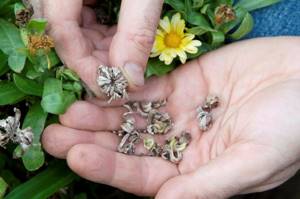
Seeds should be collected after they are almost completely ripe. To prevent self-seeding, a small gauze bag should be placed over the wilted inflorescences and secured to the stem.
Wintering
Marigolds are annuals; therefore, after they stop blooming, the bushes need to be dug up and removed from the site.
Types and varieties of calendula with photos and names
Only 2 types of marigolds are cultivated.
Field calendula (Calendula arvensis)

This species is not as popular as marigolds. The bushes grow up to 0.3 m in height. The flowers of this plant are reed-shaped, and they are colored ocher-yellow. Under natural conditions, such a plant can be found in wastelands, as well as in those areas that have been abandoned, located in the southern part of Europe. This plant must be grown in the same way as calendula officinalis.
Calendula officinalis (Calendula officinalis)

Or marigolds, or calendula, or marigold, or balaban, or crocos, or roast
This annual herbaceous plant can reach a height of 0.2–0.75 meters. The ribbed, pale green stems are quite thick, and have glandular, sticky pubescence on their surface. Simple leaf plates can be elongated or oval. On their surface you can see sparse, very hard hairs. The inflorescence baskets have a very pleasant smell that can invigorate. The inflorescences consist of orange or yellow reed flowers, which are glossy on top and matte below, as well as small tubular flowers that can be painted dark brown, yellow or orange. Flowering with proper care is quite long (from June to November). It bears abundant fruit. Breeders are always trying to develop new varieties, and their activities are divided into 2 areas: decorative and medicinal. American and European breeders are busy developing more and more decorative forms. For example, there is a group of Pacific Beauty varieties, which is a form of marigolds used for cutting, while the bush can reach 0.7 m in height, and the diameter of the baskets reaches 9 centimeters. There is also a group of Patio varieties, which is represented by small plants (about 0.3 m). And in the Kablun group there are anemoid-shaped varieties - their tubular flowers have grown relatively large.
The best decorative varieties include:
- Sonnenstein . The bush is quite compact and reaches a height of only 0.4 to 0.5 meters. The ribbed, strong stems are pale green in color. The large oblong leaf blades are also pale green. The rich yellow semi-double inflorescences have a diameter of 7.5 centimeters, while their reed flowers are curled downwards.
- Yuvel . The spherical bush can reach a height of 0.4–0.5 meters. Its pale green shoots have an irregular pentagonal cross-section. Pale green large and wide leaf blades have an oblong shape. The diameter of semi-double or double inflorescences is from 5 to 8 centimeters. They consist of yellow tubular florets and flat reed florets, colored salmon-orange.
- Radio. The height of the bush can reach from 0.35 to 0.45 meters. The ribbed stems are quite powerful. Pale green large oblong leaf plates have raised veins on their surface. The inflorescences can be semi-double or double, while they are hemispherical and reach 6–7 centimeters in diameter. The tubular flowers are orange-yellow, while the deep orange reed flowers are ½ of the way wrapped into a tube; at the base they are orange-yellow in color.

Radio - Sensation . The bush can reach 0.45 meters in height. The leaf blades are dark green. The diameter of semi-double or double inflorescences is from 7 to 8 centimeters. They consist of large glossy deep orange reed flowers that are arranged in a tiled manner, with the tubular flowers being yellow.
- Meisterstück . The height of the bush is about 0.45 m. The rich green leaf plates are quite large, elongated and widen upward. The diameter of semi-double and terry baskets is from 6 to 8 centimeters. Their tubular flowers are pale brown, and their reed flowers are paddle-shaped, slightly concave and have a deep orange color.
Also especially popular are varieties such as: Orange Koenig, Gold Koenig, Gold Kugel, Canarienvogel, Kabluna Gold, Calypso, Golden Emperor, etc.
Of the medicinal forms, the greatest interest is generated by such varieties as: Kalta, Ryzhik, Sakharovskaya orange and others, which were created by Russian breeders.
Varieties of calendula
Within the genus, about 20 plant species have been described. Based on them, many decorative garden forms have been developed, however, most often in gardens you can find calendula officinalis. For those who plant marigolds solely to obtain medicinal raw materials, you should know that the development of new varieties is carried out in two directions at once - medicinal and decorative. Moreover, Russian breeders are more focused on medicinal raw materials. Therefore, when choosing seeds for planting for the purpose of collecting and using medicinal material, you should not limit it to one well-known species.
Calendula field
A low annual variety up to 30 cm. Thick, straight stems are softly pubescent, highly branched. Along the entire length of the shoots, petiolate sessile leaves are arranged in a regular order. The flowers are solitary, small, pale mustard color. It is not in great demand among gardeners, but is often sold in flower seed stores.
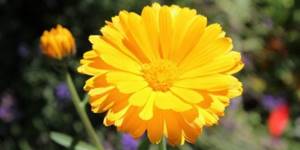
Calendula officinalis
The flowers of this variety are grown commercially for the pharmaceutical industry and are the most famous and widespread type of plant. It is correct to consider them “marigolds”. It is also an annual plant, but can have more impressive dimensions than the previous species, up to 70 cm. The shoots are straight, highly branched, colored in the same light green tone with oval simple leaves. The leaf blades are finely and softly pubescent. The flowers are yellow-orange with a slight transition to brown, the upper surface of the petals is smooth, shiny, the lower surface is matte. The central part of the inflorescence is strewn with small tubular petals, painted in the same colors. Flowering begins relatively late, by mid-summer, but continues almost until the first snow. The plant produces numerous seeds with excellent germination, which lasts up to 5 years.
Based on calendula officinalis, numerous varieties of decorative and medicinal purposes have been bred.
Both have medicinal properties and applications, but the former have priority qualities such as external characteristics and duration of flowering.
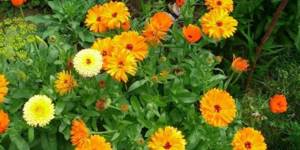
Calendula "Radio"
Medium-sized terry and semi-double, depending on the variety, grows up to half a meter. Rigid shoots with a ribbed cross-section have increased rigidity, branch well, but almost do not bend. A characteristic feature of the species is the petals twisted into a tube, the diverging rays of which are similar to antennas and look original and impressive. The inflorescences are yellow-orange, slightly lighter in the middle, and quite large, especially in double varieties.
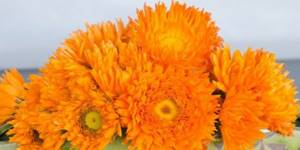
Variety "Bonbon"
The inflorescences of this variety have an external resemblance to marigolds, of a densely double type, with a rich yellow color. The stems are compact, up to 30 cm in height.
Variety "Indian Prince"
Very colorful flowers, painted in bright exotic colors. This is a tall variety, the stems of which reach 75 cm. The flowers are large, semi-double, with petals curved inward at the ends. In the center the petals are tubular, dark, with a transition to burgundy or bronze-brown. Grown by florists for cutting and making bouquets.
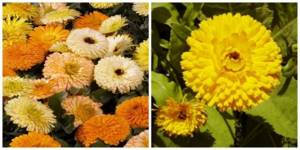
Features of the properties of calendula

Beneficial properties of calendula
Marigolds are grown on an industrial scale as medicinal raw materials. In order to create medicines from this plant, you should collect inflorescences that have just begun to open. The fact is that they contain a lot of carotenoids (carotene, flavochrome, flavoxanthin, rubixanthin, lycoline, cigroxanthin), and they also contain aponin, paraffin hydrocarbons, mucus, resins, phytoncides, bitterness, proteins, flavonoids, glycoside, malic acid , salicylic, pentadecylic and ascorbic acids and essential oil. The inflorescences of this plant have anti-inflammatory, antispasmodic, wound-healing and bactericidal effects. These flowers are used to cure diseases of the internal organs and nervous system. Thus, they are used as a diaphoretic, analgesic, sedative, expectorant and tonic. Remedies prepared on the basis of this plant can lead to relaxation of the smooth muscle structures of the stomach, intestines, and also the liver, and this helps to increase bile secretion, bile formation, as well as the secretory work of the stomach. Marigolds can effectively fight streptococci and staphylococci no worse than the most powerful antibiotic. However, this plant does not harm human health. For diseases of the epidermis such as psoriasis, allergic dermatoses, vitiligo, products made from this plant should be used both for oral administration and for external use. An aqueous solution of calendula tincture is also actively used for tonsillitis, stomatitis, sore throat, and this remedy will also help reduce bleeding gums. An ointment is also made from this plant, which is used to treat cuts, bruises, burns, eczema and cracks on the skin surface. The oil of this flower has proven effective against varicose veins, dry eczema, bedsores, and can also be drunk for gastritis, stomach and duodenal ulcers, liver diseases, colitis, enterocolitis. Calendula-based preparations are also used to eliminate nervousness during menopause and neurasthenia.
This plant is also very often used as a cosmetic product. If you wash your hair with a mixture consisting of an infusion of marigolds, hop cones and chamomile, your hair will become more beautiful, and your hair and scalp will also become healthier.
Calendula Medicinal properties and contraindications
Chemical composition of calendula
The composition of the beneficial elements of the plant is very extensive; we will present only the main ones, the most important for medicinal use.
- Carotenoids. Help relieve inflammatory processes and have an antitumor effect, including malignant neoplasms.
- Sterols. Helps in the functioning of the heart and blood vessels, removing bad cholesterol.
- Triterpenoids. Stabilization of blood glucose levels, stimulation of the immune system.
- Flavonoids. Complex effects, including restoration of mucous membranes, removal of toxic substances, bile and radionuclides, relief of spasms.
- Calenden. Rapid scarring of skin lesions, prevention and treatment of dermatitis and eczema.
- Coumarins. Reducing the risk of thrombosis, increasing vascular elasticity.
- Lactone. Antitumor effect.
This is not a complete list of the beneficial properties of calendula and the beneficial elements it contains, vitamins, acids, etc.
